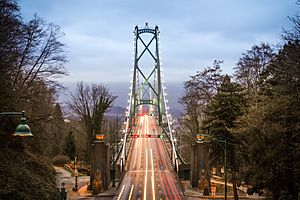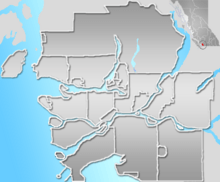Lions Gate Bridge facts for kids
Quick facts for kids Lions Gate Bridge |
|
|---|---|

Lions Gate Bridge from Stanley Park, 2013
|
|
| Coordinates | 49°18′55″N 123°8′18″W / 49.31528°N 123.13833°W |
| Carries | Three lanes of British Columbia Highway 1A/99, pedestrians and bicycles |
| Crosses | Burrard Inlet |
| Locale | Vancouver West Vancouver |
| Official name | First Narrows Bridge |
| Maintained by | British Columbia Ministry of Transportation |
| Characteristics | |
| Design | Suspension bridge |
| Total length | 1,823 m (5,981 ft) |
| Height | 111 m (364 ft) |
| Longest span | 473 m (1,552 ft) |
| Load limit | 13 tonnes (12.8 long tons; 14.3 short tons) |
| Clearance below | 61 m (200 ft) |
| History | |
| Designer | Charles Nicholas Monsarrat Philip Louis Pratley |
| Construction begin | March 31, 1937 |
| Opened | November 14, 1938 |
| Statistics | |
| Daily traffic | 60,000 – 70,000 |
| Official name: Lions Gate Bridge National Historic Site of Canada | |
| Designated: | 24 March 2005 |
| Reference #: | 11711 |
The Lions Gate Bridge is a famous suspension bridge located in Vancouver, British Columbia, Canada. It connects the city of Vancouver to the North Shore, crossing over the Burrard Inlet. This impressive bridge is recognized as one of Canada's important National Historic Sites.
Contents
What is the Lions Gate Bridge?
The Lions Gate Bridge is a very important landmark in Vancouver. It helps thousands of cars, bikes, and people cross the water every day. The bridge is known for its beautiful design and the two large concrete lions that guard its southern entrance.
A Special Type of Bridge
The Lions Gate Bridge is a suspension bridge. This means its main deck hangs from strong steel cables. These cables are supported by tall towers. The design allows the bridge to span a very long distance without needing many supports from below. It's a clever way to build bridges over wide rivers or inlets.
Where is it Located?
This famous bridge connects downtown Vancouver with West Vancouver and North Vancouver. It crosses a narrow part of the Burrard Inlet, which is why it was also called the "First Narrows Bridge." It's a key part of British Columbia Highway 1A and 99.
Building the Bridge
Building a bridge as big as the Lions Gate Bridge was a huge project! It took a lot of planning and hard work.
Who Designed It?
The Lions Gate Bridge was designed by two talented engineers: Charles Nicholas Monsarrat and Philip Louis Pratley. They created the plans for this amazing suspension bridge.
When Was It Built?
Construction on the bridge began on March 31, 1937. It took about a year and a half to build. The Lions Gate Bridge officially opened to traffic on November 14, 1938. Imagine how exciting that must have been for the people of Vancouver!
Why is it Important?
The Lions Gate Bridge is more than just a way to get across the water. It has a special place in Canadian history and is a symbol of Vancouver.
A National Historic Site
Because of its unique design and its importance to the region, the Lions Gate Bridge was named a National Historic Site of Canada on March 24, 2005. This means it's a place that tells an important story about Canada's past.
How Big is It?
The Lions Gate Bridge is very long and tall!
- Its total length is about 1,823 meters (or 5,981 feet). That's almost two kilometers!
- The main part of the bridge, called the main span, is 473 meters (1,552 feet) long.
- The towers that hold up the cables are about 111 meters (364 feet) tall.
- Ships can pass underneath because there's about 61 meters (200 feet) of space below the bridge.
What Does It Carry?
The bridge has three lanes for vehicles. These lanes can change direction depending on traffic flow to help people get where they need to go faster. It also has paths for pedestrians and bicycles, so people can walk or bike across and enjoy the views. Every day, between 60,000 and 70,000 vehicles use the bridge!
Images for kids
-
Lions Gate Bridge and North Vancouver from Prospect Point in Stanley Park











